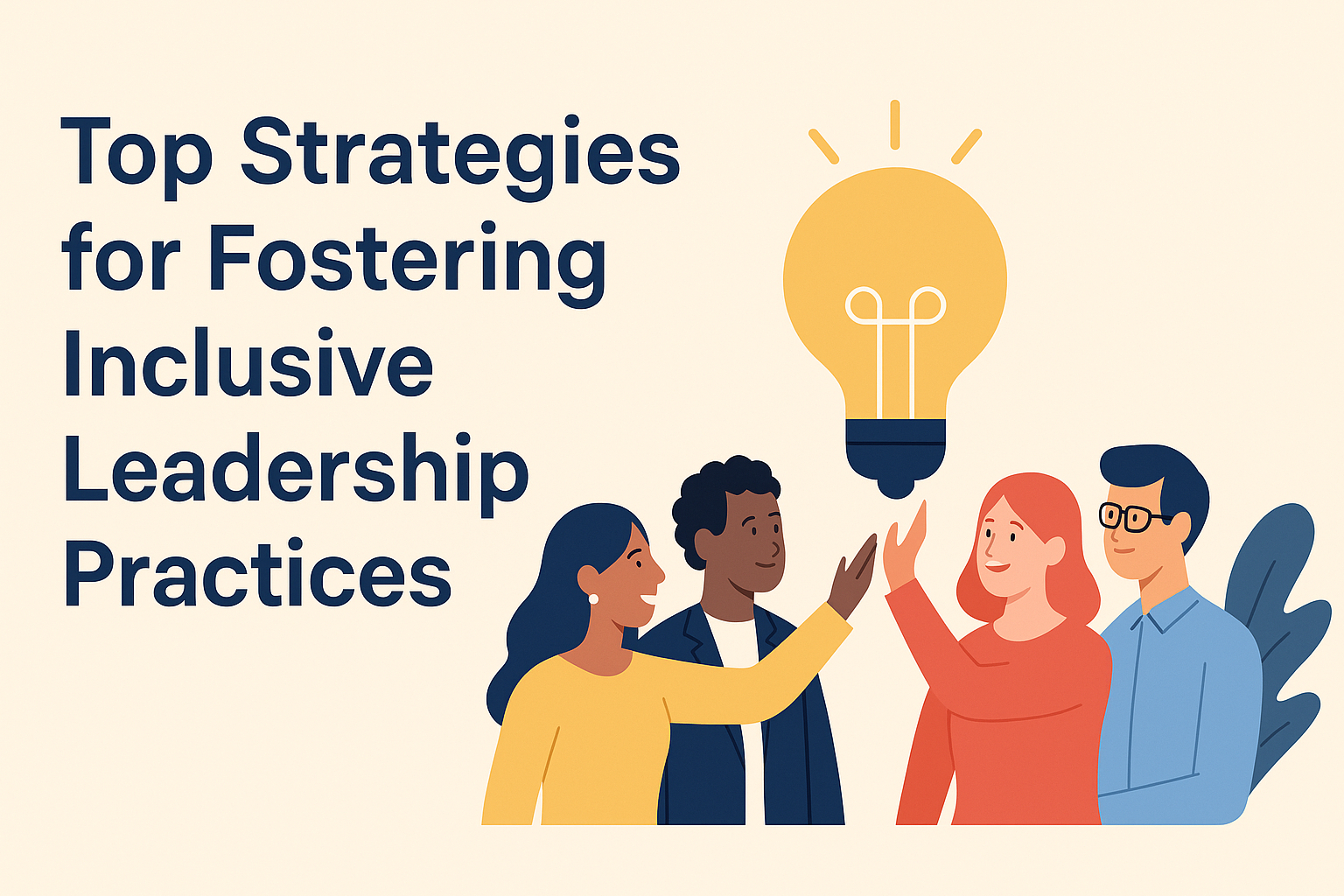Top Strategies for Fostering Inclusive Leadership Practices
Want to make every team member feel valued? This article provides practical strategies for fostering inclusive leadership practices to enhance teamwork and innovation. Learn how embracing diversity and promoting equity can transform your organization.
Key Takeaways
- Inclusive leadership enhances decision-making and innovation by valuing diverse perspectives and cultivating a supportive and appreciative workplace culture.
- Self-awareness and continuous learning are crucial for leaders to identify and mitigate personal biases, thereby promoting inclusive environments.
- Establishing inclusive policies and empowering employees are crucial strategies for creating equitable workplaces that support diverse talent and maintain a culture of psychological safety.
✅ Ready to lead with more impact and inclusivity? Book a free 15-minute strategy session to explore how inclusive leadership can transform your organization.
👉 Book a call now
Embracing Diversity and Inclusion

Inclusive leadership is not just about having diverse teams; it’s about recognizing the unique value that diverse perspectives bring to the table. Embracing diversity and inclusion enhances decision-making and innovation among leaders. Organizations with diverse leadership often outperform their competitors financially and in terms of innovation. For example, Salesforce integrates diverse voices into their decision-making processes, fostering innovative strategies that drive their success.
Inclusive leaders actively seek out diverse opinions to challenge the status quo, leading to richer discussions and more creative solutions. They understand that a variety of viewpoints can uncover blind spots and lead to better decision-making. This commitment to diversity and inclusion not only improves employee satisfaction and engagement but also contributes to a more innovative and dynamic organizational culture. When leaders visibly commit to DEI training, it reinforces the notion that fostering an inclusive culture is a collective responsibility.
Actively promoting an inclusive workplace culture ensures that every team member feels valued and respected. This, in turn, enhances team collaboration and cohesion, creating an environment where employees are motivated to contribute their best. Ultimately, inclusive leadership is about creating a sense of belonging and ensuring that diverse needs are met through thoughtful inclusion strategies and initiatives.
✨ Want your leadership team to embrace DEI like Salesforce does? Let’s talk about practical, customized strategies that work.
📅 Schedule your 15-minute call
Cultivating Self-Awareness
Self-awareness is a cornerstone of inclusive leadership. Recognizing personal biases and understanding how they influence interactions is crucial for creating an inclusive workplace culture. Leaders must engage in ongoing education and self-awareness practices to identify and mitigate their own biases. Participating in unconscious bias training workshops is an effective way to improve this awareness and foster an environment of mutual respect.
Continuous effort and commitment to self-improvement are essential for inclusive leadership. Cultivating a deep understanding of their own cultural biases and personal challenges helps leaders better appreciate diverse perspectives within their teams. This awareness not only promotes open communication but also enhances employee engagement by ensuring that all team members feel heard and valued through inclusive practices in inclusive environments, fostering true inclusion and inclusive cultures.
🔍 Curious how to identify and overcome your unconscious biases as a leader? Let’s uncover your blind spots together.
📞 Book your discovery call
Promoting Open Communication
Open communication is the lifeblood of an inclusive workplace culture. Inclusive leaders prioritize fostering open dialogues, allowing diverse voices to be heard and respected, including discussions about sexual orientation. Creating an environment that encourages conversations about biases and mental health helps build trust and transparency among employees. This transparency, in turn, boosts engagement and team cohesion.
Active listening is an essential skill for inclusive leaders. It helps them to:
- Understand diverse perspectives better.
- Truly hear and appreciate the unique viewpoints of their team members, which helps mitigate biases and foster a culture of mutual respect.
- Use empathy to understand different perspectives, especially when providing feedback across different cultures.
- Encourage bottom-up communication, allowing all team members to contribute ideas and enhancing team ownership and trust through attentive listening. Critical role.
Leaders can increase psychological safety by:
- Regularly holding one-on-one meetings and promoting open dialogue in team settings.
- Sharing relevant information transparently to reduce miscommunication and build stronger team connections.
- Creating norms around handling failures as learning opportunities rather than punishable offenses to foster a culture of continuous improvement and innovation.
💬 Great communication unlocks team potential. If you’re ready to create a culture of trust and dialogue, let’s chat.
📆 Claim your spot on my calendar
Building Diverse Teams

Building diverse teams is a fundamental aspect of inclusive leadership. Inclusive leaders understand the value of diverse perspectives and diverse backgrounds in enhancing innovation and decision-making. Prioritizing skills-based hiring practices creates more inclusive job opportunities that focus on a candidate’s abilities rather than formal education. This approach ensures a more equitable hiring process and a richer pool of talent.
Empowering team members to share their insights is key competencies to making more informed and innovative decisions. Inclusive leaders prioritize open communication, allowing all team members to express their thoughts and contribute fully. Cultural competence is essential for leaders to navigate decision-making processes effectively in diverse teams, ensuring that every team member feels valued and included, drawing on collective wisdom.
Implementing Inclusive Policies

Inclusive policies are the backbone of an inclusive workplace culture. Inclusive leaders recognize the importance of establishing policies that support a diverse workforce. For instance, Siemens China implemented a flexible work system even before the COVID-19 pandemic, which improved efficiency and personal ownership among employees. Additionally, their mentorship program supports employee growth and development, demonstrating a commitment to fostering an inclusive environment.
Organizations that implement inclusive leadership through diverse policies attract higher-quality talent and enhance their reputation, contributing to long-term success. Utilizing tools like anonymous recruitment processes and diversity resources significantly minimizes biases in the workplace.
Creating inclusive policies ensures that all employees feel valued and supported, ultimately driving organizational success.
👥 Struggling to build a truly diverse and high-performing team? Let me help you refine your hiring and inclusion strategies.
📲 Book your 15-minute consultation
Championing Psychological Safety
Psychological safety is a hallmark of a healthy, inclusive culture. It ensures that employees feel secure to express themselves without fear of judgment or negative consequences. Organizations that foster psychological safety are better equipped to leverage the full potential of their diverse talent. Teams with high psychological safety experience improved performance and reduced conflicts.
Empathy in leadership enhances team relationships and contributes to a supportive workplace atmosphere. However, the rise of remote work has complicated the establishment of psychological safety due to challenges in building interpersonal trust. Leaders must actively promote open communication and foster environments where team members feel valued and supported, regardless of their work setting.
Encouraging Continuous Learning
Continuous learning is essential for cultivating inclusive leadership. Incorporating DEI education into the organizational training schedule emphasizes its importance and integrates it into overall professional development. Offering DEI resources through various mediums, such as workshops and podcasts, caters to different learning styles and makes access easier.
Using employee surveys to gauge interest in specific DEI topics helps tailor educational content to meet diverse needs. Microlearning strategies enable employees to learn strategies to digest DEI information in short, manageable segments, enhancing retention.
Investing in continuous learning helps organizations maintain an inclusive culture that supports diverse needs and fosters continuous improvement.
Empowering Employees
Empowering employees is a critical component of inclusive leadership and effective leadership style. Key approaches include:
- Mentorship and sponsorship: Important for helping team members feel supported and ensuring equitable opportunities for growth.
- Business coaching: Focuses on enhancing skills and performance through structured guidance.
- Mentoring: Provides long-term insights and support based on real-world experience.
Inclusive leaders empower their employees by:
- Offering support and resources
- Implementing initiatives like employee resource groups and mentorship programs to support inclusivity and development
- Helping team members recognize their strengths, which empowers their development paths and enhances overall organizational success. An inclusive leader fosters an environment where everyone can thrive, making them a true leader in promoting inclusivity.
🧠 Psychological safety isn’t a luxury—it’s a leadership necessity. Want to learn how to foster it in your team?
🚀 Let’s talk strategy
Measuring Impact and Progress
Measuring the impact and progress of inclusive initiatives is vital for continuous improvement. Tracking metrics like employee satisfaction and engagement helps organizations assess the effectiveness of their diversity, equity, and inclusion efforts. Regularly analyzing both quantitative and qualitative data, including performance evaluations, is essential for assessing the impact of inclusion efforts.
Using anonymous surveys can help organizations gather honest feedback on inclusion efforts, as employees feel safer voicing their opinions. Benchmarking inclusion metrics against industry standards allows organizations to set realistic goals and identify areas for enhancement.
Regularly reviewing and updating equity practices helps organizations remain effective in addressing systemic inequalities.
Addressing Cultural Biases
Addressing cultural biases is crucial for sustaining an inclusive workplace culture. Developing cultural competence requires leaders to assess their own cultural biases and actively seek knowledge about other identities. Inclusive leaders must reevaluate existing systems to identify and rectify biases.
Unconscious biases and structural inequalities need to be recognized and addressed to sustain an inclusive culture. Training in cultural diversity and inclusion often emphasizes the importance of adapting communication styles to suit multicultural teams. Challenging stereotypes enhances workplace inclusivity and fosters greater appreciation of individuals’ unique contributions.
Creating Opportunities for All

Creating opportunities for all is a fundamental responsibility of inclusive leaders. They must recognize their privilege and use it to foster equitable and inclusive workplaces. Psychological safety is essential for fostering an open workplace. It enables employees to share their ideas without fear of facing negative repercussions.
Workplace equity involves tailoring opportunities for employees based on their individual circumstances and needs. Organizations that prioritize equitable treatment often recognize that not all employees have the same access to resources or advantages. Inclusive leaders ensure fair treatment for employees by championing equity and addressing systemic inequalities.
Enhancing Employee Engagement
Enhancing employee engagement is essential for fostering an inclusive workplace culture. Celebrating DEI milestones and recognizing contributions fosters motivation among employees to engage in continuous learning efforts. Regular recognition of employee contributions can enhance morale and positively influence mental health.
Offering paid volunteer time off enhances employee engagement by allowing them to contribute to causes they care about while still being compensated. Personalizing engagement programs by allowing employees to choose meaningful action causes to support increases their willingness to participate.
Effective employee engagement strategies can significantly impact overall job satisfaction and productivity.
💡 Empowerment drives performance. Let’s co-design a leadership approach that helps every employee thrive.
🎯 Book your free session
Nurturing Mental Health and Well-being
Nurturing mental health and well-being is a key component of an inclusive workplace culture. Establishing clear work-life boundaries aids in mitigating stress and preventing burnout. Leaders prioritizing their own mental health set a positive example that can influence organizational culture.
Encouraging short breaks during the workday can help refresh employees’ minds and boost creativity. Clear job role definitions can alleviate uncertainty and reduce stress among employees. Creating space involves recognizing diverse needs and supporting a healthy balance through flexible working arrangements.
Fostering Innovation Through Inclusion

Inclusive leadership plays an essential role in driving innovation and overall organizational success by embracing diverse perspectives. Diverse teams enhance creativity and lead to better problem-solving and innovative solutions. Establishing a psychologically safe environment encourages innovative thinking and collaborative problem-solving.
Fostering an inclusive workplace culture create opportunities for all employees to contribute their unique insights. This not only spark innovation but also ensures that the organization remains adaptable and resilient in the face of complex challenges, highlighting the importance of workplace inclusion.
Summary
Inclusive leadership is a dynamic and powerful approach to building a thriving, innovative, and resilient organization. By embracing diversity and promoting open communication, leaders can create an inclusive workplace culture where every team member feels valued and their unique perspectives are celebrated. Implementing inclusive policies and fostering psychological safety are crucial for supporting a diverse workforce and driving organizational success.
In conclusion, the journey towards inclusive leadership requires continuous learning, self-awareness, and a commitment to equity and inclusion. By empowering employees and nurturing mental health and well-being, leaders can create a workplace where everyone can thrive. Let us embrace the power of inclusive leadership and create a brighter, more inclusive future for all.
🌈 If inclusive leadership is the future, now’s the time to lead the way. I’m offering a limited number of 15-minute strategy sessions for leaders serious about change.
📌 Click here to reserve yours
Frequently Asked Questions
What is inclusive leadership?
Inclusive leadership is essential for creating a workplace culture that values diversity and promotes open communication, ensuring that all team members feel valued and respected. This approach leads to enhanced collaboration and innovation within teams.
How can leaders recognize and address their own biases?
Leaders can effectively recognize and address their own biases through continuous education and self-reflection, particularly by participating in unconscious bias training. This proactive approach fosters a more inclusive environment.
Why is psychological safety important in the workplace?
Psychological safety is crucial in the workplace because it allows employees to express themselves freely without fear of judgment, resulting in enhanced performance, reduced conflicts, and increased innovation. This supportive environment fosters a more collaborative and productive workforce.
What are some effective strategies for enhancing employee engagement?
Enhancing employee engagement can be effectively achieved by celebrating DEI milestones, recognizing individual contributions, providing paid volunteer time off, and personalizing programs to align with employees’ interests. These strategies foster a more inclusive and motivated workplace culture.
How can organizations measure the impact of their diversity, equity, and inclusion initiatives?
Organizations can effectively measure the impact of their diversity, equity, and inclusion initiatives by tracking metrics like employee satisfaction and engagement, analyzing both qualitative and quantitative data, and utilizing anonymous surveys for honest feedback. Benchmarking against industry standards also provides valuable context for understanding progress.



